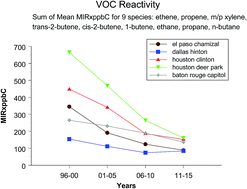Trends analyses of 30 years of ambient 8 hour ozone and precursor monitoring data in the South Central U.S.: progress and challenges
Abstract
In the last 30 years ambient ozone concentrations have notably decreased in the South Central U.S. Yet, current ambient ozone concentrations measured over the past three years 2013–2015 in this area of the U.S. are not meeting the U.S. 2015 8 hour ozone standard of 70 parts per billion (ppb). This paper provides an update on long-term trends analyses of ambient 8 hour ozone and ozone precursor monitoring data collected over the past 30 years (1986–2015) in four South Central U.S. cities, following up on two previously published reviews of 20 and 25 year trends for these cities. All four cities have benefitted from national ozone precursor controls put in place during the 1990s and 2000s involving cleaner vehicles (vehicle fleet turnover/replacement over time), cleaner fuels, cleaner gasoline and diesel engines, and improved inspection/maintenance programs for existing vehicles. Additional ozone precursor emission controls specific to each city are detailed in this paper. The controls have resulted in impressive ambient ozone and ambient ozone precursor concentration reductions in the four South Central U.S. cities over the past 30 years, including 31–70% ambient nitrogen oxides (NOx) concentration declines from historical peaks to the present, 43–72% volatile organic compound (VOC) concentration declines from historical peaks to the present, a related 45–76% VOC reactivity decline for a subset of VOC species from historical peaks to the present, and an 18–38 ppb reduction in city 8 hour ozone design value concentrations. A new challenge for each of the four South Central U.S. cities will be meeting the U.S. 2015 8 hour ozone standard of 70 ppb.


 Please wait while we load your content...
Please wait while we load your content...